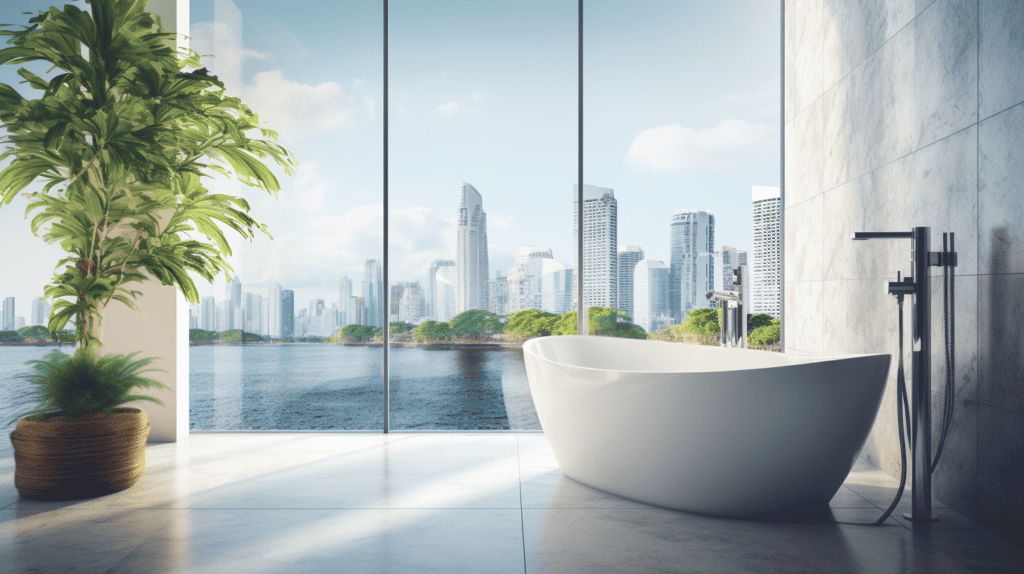
In this article, we explore choosing the perfect bathtub! Whether you’re remodeling your bathroom or just looking to upgrade, this guide will help you find the ideal bathtub that fits your needs, style, and budget.
Why a Perfect Bathtub Matters
A bathtub is more than just a place to get clean; it’s a sanctuary for relaxation and self-care. A perfect bathtub can turn an ordinary bathroom into a spa-like retreat, helping you unwind and rejuvenate.
Types of Bathtubs
When choosing a bathtub, it’s essential to understand the different types available. Each type has its unique features and benefits.
Freestanding Bathtubs
Freestanding bathtubs are standalone fixtures that can be placed anywhere in the bathroom. They are often the centerpiece of a bathroom design and come in various styles, from modern to classic clawfoot tubs.
- Pros: Stylish, versatile placement
- Cons: Requires more floor space, potentially higher cost
Alcove Bathtubs
Alcove bathtubs are installed in a three-walled enclosure, making them a popular choice for smaller bathrooms.
- Pros: Space-saving, cost-effective
- Cons: Limited design options
Corner Bathtubs
Corner bathtubs are designed to fit into a corner, making them an excellent choice for maximizing space.
- Pros: Space-efficient, unique design
- Cons: It can be more challenging to clean
Drop-In Bathtubs
Drop-in bathtubs are installed within a constructed deck or platform, allowing for more customization in design.
- Pros: Customizable, luxurious appearance
- Cons: Requires more installation work
Choosing the Right Material
The material of the bathtub affects its durability, maintenance, and overall look. Here are some common materials to consider:
Acrylic
Acrylic is lightweight, durable, and retains heat well. It’s also available in many shapes and sizes, making it versatile.
- Pros: Easy to clean, affordable
- Cons: Can scratch easily
Cast Iron
Cast iron bathtubs are coated with enamel, making them incredibly durable and heat-retentive. They offer a classic, timeless look.
- Pros: Long-lasting, excellent heat retention
- Cons: Very heavy, expensive
Fiberglass
Fiberglass bathtubs are lightweight and affordable, making them popular for budget-conscious homeowners.
- Pros: Cost-effective, easy to install
- Cons: Less durable, prone to staining
Stone Resin
Stone resin bathtubs offer a luxurious look and feel, mimicking natural stone. They are durable and retain heat well.
- Pros: High-end appearance, durable
- Cons: Expensive, heavy
Measuring Your Space
Before purchasing a bathtub, measuring your bathroom space accurately is crucial. Here are the steps to ensure a perfect fit:
- Measure the Length and Width: Measure the available floor space where the bathtub will be installed.
- Consider the Height: Ensure enough clearance for the bathtub’s height, especially if you have low ceilings.
- Check Doorways and Hallways: Make sure the bathtub can be maneuvered through doorways and hallways to reach the bathroom.
Features to Consider
When choosing a bathtub, consider additional features to enhance your bathing experience.
Jets and Whirlpool Options
For a therapeutic experience, consider a bathtub with jets or a whirlpool system. These features provide a massaging effect, perfect for relaxing sore muscles.
Built-in Seating
Some bathtubs have built-in seating, offering added comfort and convenience, especially for those with mobility issues.
Slip-Resistant Surface
Safety is essential, so look for bathtubs with slip-resistant surfaces to prevent accidents.
Faucet and Showerhead Compatibility
Ensure your chosen bathtub is compatible with your existing faucet and showerhead, or plan to purchase new fixtures that match your bathtub’s style.
Installation Considerations
Proper installation is crucial for the longevity and functionality of your new bathtub. Here are some key points to consider:
Professional vs. DIY
- Professional Installation: Hiring a professional ensures the job is done correctly, especially for complex installations like drop-in or freestanding tubs.
- DIY Installation: If you’re handy and have the necessary tools, DIY installation can save money. However, be prepared for potential challenges.
Plumbing Requirements
Ensure your bathroom’s plumbing can accommodate the new bathtub, especially if upgrading to a larger or more complex model.
Structural Support
Consider the weight of the bathtub, especially if you choose a heavy material like cast iron. You may need to reinforce the floor to support the added weight.
Maintenance Tips
To keep your bathtub looking new and functioning well, follow these maintenance tips:
- Regular Cleaning: Clean your bathtub regularly with non-abrasive cleaners to prevent stains and buildup.
- Check for Leaks: Periodically inspect the plumbing connections for any signs of leaks.
- Prevent Scratches: Avoid using harsh scrubbing pads that can scratch the bathtub’s surface.
Conclusion
Choosing the perfect bathtub involves considering various factors, including the type, material, size, and additional features. By understanding your needs and preferences, you can make an informed decision that transforms your bathroom into a relaxing oasis.